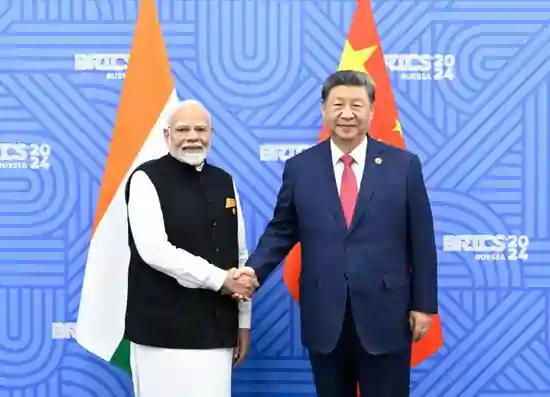New Delhi: In a landmark statement on April 1, 2025, Chinese President Xi Jinping called for a revitalized partnership between China and India, likening their relationship to a “Dragon-Elephant tango.” This evocative metaphor, symbolizing a harmonious yet dynamic interplay between the dragon of China and the elephant of India, was part of congratulatory messages exchanged with Indian President Droupadi Murmu to mark the 75th anniversary of diplomatic ties between the two nations. As the world’s two most populous countries and rising powers of the Global South, this milestone offers a critical opportunity to redefine their bilateral relationship amid a history of tension and recent efforts toward reconciliation.

A Milestone Moment: 75 Years of India-China Relations
The year 2025 marks 75 years since India and China formally established diplomatic relations on April 1, 1950. This anniversary arrives at a pivotal juncture, with both nations navigating a complex landscape of geopolitical rivalry, economic interdependence, and unresolved border disputes. Xi’s message, echoed by Indian Prime Minister Narendra Modi and Chinese Premier Li Qiang in their own exchanges with counterparts, underscores a shared desire to move beyond past conflicts and build a stable, mutually beneficial partnership.
Xi described India and China as “ancient civilizations, major developing countries, and key members of the Global South,” emphasizing their shared stakes in a rapidly changing global order. Speaking to reporters in Beijing, Chinese Foreign Ministry spokesperson Guo Jiakun reinforced this sentiment, noting that both nations are at a “crucial stage of modernization” and that cooperation, rather than confrontation, is the “right path” forward.
The ‘Dragon-Elephant Tango’: A Vision for Coexistence
The phrase “Dragon-Elephant tango” is more than a poetic flourish—it encapsulates the delicate balance of competition and collaboration that defines India-China relations. The dragon, a symbol of China’s assertive rise, and the elephant, representing India’s steady emergence, must find a rhythm that allows both to thrive. Xi stressed that this partnership should be rooted in “mutual respect, mutual sensitivity, and mutual interest,” a threefold formula he believes can provide a “durable base” for rebuilding ties.
This vision comes as tensions have eased following the deadly 2020 Galwan Valley clash along the Line of Actual Control (LAC), a 3,488-kilometer border that remains a flashpoint due to its lack of mutual demarcation. Recent diplomatic breakthroughs, including the October 2024 meeting between Xi and Modi in Kazan, Russia, and the December 2024 Special Representatives dialogue between National Security Advisor Ajit Doval and Chinese Foreign Minister Wang Yi, signal a thaw in relations. These efforts have culminated in troop disengagement at friction points like Demchok and Depsang in eastern Ladakh, a process India’s Ministry of External Affairs (MEA) confirms is “proceeding as per schedule.”
Key Challenges in India-China Relations
Despite the optimism, significant hurdles remain. The unsettled border is the most persistent issue, with military skirmishes—like the 2020 clash that killed 20 Indian and an undisclosed number of Chinese soldiers—highlighting the stakes. India views China’s Belt and Road Initiative (BRI), particularly the China-Pakistan Economic Corridor (CPEC) running through disputed Kashmir, as a strategic encirclement, fueling geopolitical rivalry. Meanwhile, China’s military and economic support to Pakistan, including advanced weaponry, adds another layer of complexity to India’s security concerns.
Economically, the relationship is lopsided. India’s trade deficit with China ballooned to $85.1 billion in FY 2024, driven by heavy reliance on Chinese imports like electronics and machinery. This imbalance has prompted calls in India for greater self-reliance, even as Chinese investments in Indian startups and infrastructure remain significant.
A Path Forward: Diplomacy and Economic Balance
Xi’s call for a “Dragon-Elephant tango” aligns with concrete steps both nations are taking to stabilize ties. Diplomatic mechanisms like the Working Mechanism for Consultation and Coordination (WMCC) and Border Personnel Meetings have been instrumental in managing the LAC. The March 25, 2025, talks in Beijing between MEA Joint Secretary Gourangalal Das and Chinese Director General Liu Jinsong focused on practical cooperation, including resuming direct flights—halted since 2020—and restarting the Kailash Mansarovar Yatra, a pilgrimage of deep cultural significance to Indians.
Economic interdependence is another pillar of this reset. Both sides are exploring ways to balance trade, with India pushing for greater market access for its goods in China and China seeking to deepen investment ties. Modi has emphasized that a strong India-China relationship is “conducive for a stable and multipolar world,” a view Xi echoed by pledging to “jointly safeguard peace and tranquility” in border areas.
Global Implications of a Stronger India-China Bond
The implications of this partnership extend far beyond Asia. As members of the Global South, India and China have a shared interest in advocating for a multipolar world and greater representation in international institutions. Xi highlighted the need for “communication and coordination in major international affairs,” a nod to their roles in forums like BRICS and the Shanghai Cooperation Organisation (SCO). Their collaboration could shape global responses to climate change, trade policies, and regional security, particularly in the Indo-Pacific.
However, their rivalry complicates this picture. India’s alignment with the U.S. through the Quad and China’s expanding influence via the BRI underscore their competing visions for global leadership. A successful “tango” will require both nations to navigate these tensions without stepping on each other’s toes.
Voices from the Ground: Leaders and Citizens Weigh In
President Murmu, in her message to Xi, called for a “stable, predictable, and friendly” relationship, reflecting India’s cautious optimism. Modi, meanwhile, has framed the anniversary as a chance to “promote sound and steady development,” a sentiment that resonates with Indian businesses eager to tap into China’s market while reducing dependency.
On the Chinese side, Premier Li Qiang’s message to Modi emphasized practical cooperation, while Foreign Minister Wang Yi, speaking last month, described the “ballet between the elephant and dragon” as the “only right choice.” Guo Jiakun hinted at upcoming events to celebrate the anniversary, though specifics remain under wraps, promising further momentum in bilateral engagement.
Historical Context: A Relationship of Highs and Lows
The India-China relationship has oscillated between cooperation and conflict since the 1950s. The 1962 Sino-Indian War over Aksai Chin left a lasting scar, and subsequent decades saw mistrust dominate. The 1988 visit by Rajiv Gandhi marked a turning point, paving the way for trade growth in the 1990s and 2000s. Yet, incidents like the 2017 Doklam standoff and the 2020 Galwan clash tested this progress.
Today’s thaw builds on this history, with both nations recognizing that rivalry serves neither’s interests in a world of economic uncertainty and geopolitical flux. The “Dragon-Elephant tango” thus represents not just a diplomatic ideal but a pragmatic necessity.
Conclusion: A Dance Worth Perfecting
As China and India step into the next phase of their 75-year journey, Xi’s “Dragon-Elephant tango” offers a compelling vision: two giants moving in sync, not in opposition. The road ahead demands patience, compromise, and bold diplomacy to resolve lingering disputes and harness their combined potential. If successful, this partnership could not only transform Asia but also redefine the global order. For now, the world watches as the dragon and elephant take their first tentative steps toward a shared rhythm.

